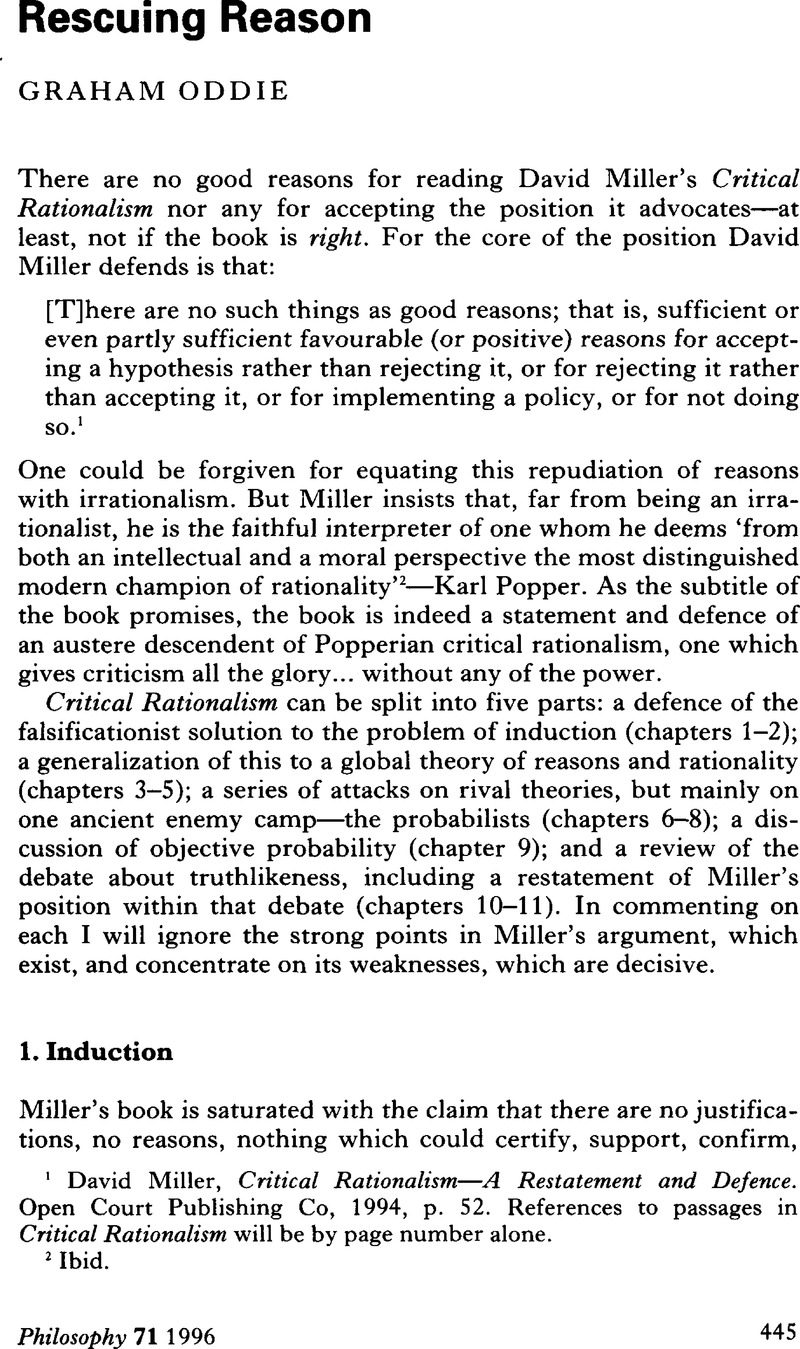Published online by Cambridge University Press: 30 January 2009

1 Miller, David, Critical Rationalism — A Restatement and Defence. Open Court Publishing Co, 1994, p. 52. References to passages in Critical Rationalism will be by page number alone.Google Scholar
2 Ibid.
3 p. x.
4 p.l.
5 p.l.
6 p. 13.
7 p. 6.
8 p. 10. 446
9 p. 11.
10 p. 13.
11 p. 35.
12 p. 37.
13 p. 36.
14 p. 54.
15 p. 37.
16 p. 38.
17 p. 55.
18 p. 55.
19 p. 55 448
20 p. 30.
21 This is, of course, the real meaning of Hume's claim that ‘Reason is and only ought to be the slave of the passions and can never pretend to any other office than to serve and obey them.’ Hume, David, A Treatise of Human Nature Book II, Part III, (Oxford: Clarendon, 1967) p. 416. Miller characterizes this as ‘...Hume's lurch into the disastrous doctrine that there is no ... self-respecting role for reason itself.’ (p. 52), and traces it to his repudiation of induction. This is a strange interpretation of Hume's dictum, for the thrust of the surrounding passages is that even though beliefs can be rationally assessed, there is no possible rational assessment of passion or desire.Google Scholar
22 p. 56. 450
23 p. 96.
24 Spelling out this finer-grained notion is a daunting philosophical task, but it can be done. For an excellent attempt, see Tichy, PavelThe Foundations of Frege's Logic (Berlin: de Gruyter, 1988), chapters 1 and 5.CrossRefGoogle Scholar
25 p. 127.
26 p. 128. 452
27 For simplicity let the cognitive value of correct classification be 1 and that of incorrect classification 0. Then the expected value of classifying H true = P(HE)X value of correct classification + P(not-HE) × value of incorrect classification = P(HE) × 1 + P(not-HE) times; O = P(HE).
28 A slightly less crude, but still far too crude, account makes cognitive value a function of two factors: truth value and degree of logical content. Certainly as a measure of closeness to truth any such function has well documented and fatal shortcomings. See Oddie, GrahamLikeness to Truth, (Dordrecht: Reidel, 1986), p. 33 and pp. 42–44.CrossRefGoogle Scholar
29 p. 150. 454
30 Because of the way Miller has set it up the result of the candlelight experiment is misleading, and our acquirer will end up performing a sub-optimal act. But that in itself is not an objection to his rationality, and it is certainly not an objection Miller would want to buy into. Rationality, by his lights, is a matter of the process not the product.
31 Miller's final objection to Bayesianism (chapter 8) is rather speculative, as he himself admits. Subjective probability distributions may turn out to be chaotic, undermining the claim, often made by Bayesians, that initial differences in subjective opinion will eventually be swamped by the evidence and there will be convergence in opinion. This certainly seems like a topic worthy of further investigation.
32 pp. 185–6.
33 p. 186.
34 See Oddie, Graham and Menzies, Peter, ’An objectivist's guide to subjective value’ in Ethics, 102 (3), 512–34, (1992).CrossRefGoogle Scholar
35 Miller does mention Lewis's, David ‘A subjectivist's guide to objective chance’ in R, Carnap and R., JeffreyStudies in Inductive Logic vol 2, (Berkeley: University of California, 1980)) in which the principle (called by Lewis the ‘Principal Principal’) is put to good work.Google Scholar
36 p. ix.
37 pp. 196–7.
38 Quite generally PA is the property given by: Px = (x = A). Note that this has the crucial interdefinability feature which Miller values in such transformations: indeed ‘nothing could be more deliciously symmetrical’ (p. 226). For it is not hard to check that we have: P = (PA).
39 Another is that the purported ‘respecifications’ turn out not to be genuine respecifications at all, but specifications of distinct entities. I argued for this at length in chapter 6 of my Likeness to Truth, and those arguments have not yet been satisfactorily addressed.
40 p. 231.
41 See Armstrong, DavidUniversals and Scientific Realism (Cambridge University Press, 1978). Armstrong is not very clear on the details of the proposal. Some work along these lines has been done by Peter Vallentyne in ‘A Temperate Theory of Universals’ (forthcoming).Google Scholar
42 Miller makes a related objection: ‘It might be thought that if K influences the values of [the distance function] then the claim that K is an advance on H will be a spurious one; for if H influenced [the distance function] perhaps the judgment would be reversed.’ p. 208.
43 See Niiniluoto, IllkaTruthlikeness (Dordrecht: Reidel, 1987), chapter 12.CrossRefGoogle Scholar
44 Take each of the possible candidates for truth, Tx, T2, … etc. If T iwere the truth then certain attributes would be privileged and each hypothesis would be assigned a distance from Ti itself. In particular, H will be assigned a distance di from T;. The expected distance of H from the truth will then be the weighted average of all the di's (i = 1,2, …), the weight given to each di being the probability, on the evidence, of Ti.